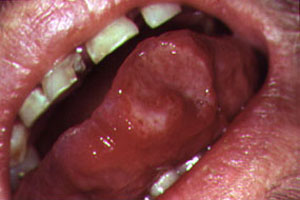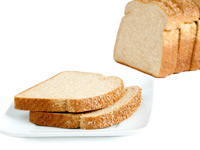Although there are three main types of canker sores, which are based on the size, how long they last and whether or not they leave scarring, they all go through the same stages before healing.
 Prodromal Stage
Prodromal Stage
Before a mouth sore actually forms, it will typically begin with a slight tingling or burning sensation at the site where the sore is going to develop. Sores can be anywhere inside the mouth, including the tip or underside of the tongue, roof of the mouth (called the soft palate), the floor of the mouth, the inner cheeks and lips, as well as the gums and even the tonsil area. Typically there is no feeling of malaise involved. Canker sores are distinguished from cold sores partly by the fact that they appear only inside the mouth, whereas cold sores of fever blisters appear on the outside of the mouth.
Pre-ulcerative Stage
By around the second day, a raised reddened area forms and the pain may increase. This stage may last a day or so before the sore actually erupts and the open lesion develops.
Ulcerative Stage
By around the third day the canker sore officially rears its ugly head in all its glory: it is now a shallow ulcer that can be round or oval and white or yellowish in color, surrounded by a bright red rim. The center is often covered by a white or greyish membrane. It is now quite painful and sensitive, especially when you try to eat or drink anything. This stage can last anywhere from three to seven days. During this period the pain may stay the same or even increase, making eating and drinking, and sometimes even talking, excruciatingly painful.
Healing Stage
By the seventh or eighth day, the symptoms thankfully start to subside. The pain will likely start the recede as the sore begins to heal. The ulcer grows smaller as healthy tissue closes over it and eating and drinking start to feel less painful. Some sores may take longer to heal. Major aphthae are large, deep ulcerations, often 1/2 inch in diameter or more, and can take as long as two to four weeks to heal. Most canker sores do not leave a scar, by major aphthous ulcers may cause scarring.
If your canker sore is taking a long time to heal or it is exceedingly painful, you should have it evaluated by your doctor. In rare cases canker sores can be associated with immuno-compromised conditions.
Remission Stage
This is best stage of all: the ulcer is completely gone. However, for some people it is only temporary relief and soon one or more canker sores are forming again. If you suffer from frequent outbreaks there may be underlying health issues involved. Some people find their frequent sores are caused by a nutritional imbalance or vitamin deficiency, a gastrointestinal condition such as celiac disease, or even the sodium laurel sulfate in toothpaste. The latter may be resolved by simply switching toothpastes to a product that is SLS-free. You can find several brands such as Toms of Main, Jason Powersmile and Rembrandt C at drugstores or health food stores. Some people find this really makes a difference on the frequency of their outbreaks.
Preventing Your Canker Sore From Getting Worse
While it isn’t always possible to prevent your lesion from developing, you may be able to take some steps to help speed the healing process.
According to a research study by Ben Gurion University, a daily 1000 mcg dose of vitamin B12 has been shown to reduce or even eliminate canker sores. It is certainly worth a try.
Gargling with a mixture of hydrogen peroxide and water, salt and water or baking soda and water four times per day may help. Hydrogen peroxide helps kill bacteria and baking soda helps alkalinize the mouth, preventing it from being too acidic.
Other home remedies that may promote healing include bee propolis, aloe vera, and licorice root.


11 thoughts on “Canker Sore Stages”
Thank you so much but I’m taking strepsils and vitamin C, yeah and water mixed with salt and this morning the pain increased ????????Guess I can’t drink my coke anymore
Coke should be the last thing you desire to have when, your body is already telling you there is some sort of imbalance in the first place, with the canker sore. When you drink any kind of soda, you intentionally are putting your body through the same chemical cycle as if being on heroine. Use this as a time to figure out why you are using coke as an outlet, and what you can replace it with, that has beneficial properties. I hope you heal soon.
Since when does a Cherry coke = Heroine?
coke is just as bad for you as heroine in the long run, if you drink it everyday like some people..
When your sore was almost healed was there a phase where the outsides became more reddened?
this has happened to me it’s nothing to worry about
Good post! I would add Gly-Oxide as a good treatment.
http://definitelynotcancer.com/2018/02/11/how-long-does-it-take-a-canker-sore-to-heal/
its day 6 right now hopefully it heals quickly.
Mine is day five and still hurts my previous canker sores heal on or before the fourth day I think I had two that merged hopefully tomorrow the pain is gone and I eat and talk properly.
I used Alum mixed in warm water also salt mixed in warm water too,vitamin B complex placed directly on the sore it hurts in fact all the methods hurt I used a gel for canker sores gave me relief for about 30 minutes if I eat, while if i don’t eat or talk about 2 hours then stinging pain starts crawling back slowly
I switched to an electric toothbrush and I don’t get canker sores anymore. I used to get them monthly from just biting my lip and a couple days later it would turn into one, lasting sometimes 3-4 weeks before healing fully. Now that I use an electric toothbrush I’ve gotten maybe 1 in the last year.
I still bite my lip all the time. But not it jeals heals in a day. I assume it’s because when I brushed before I would do so fairly vigorously and probably pulled the skin/wound open more by doing that. With the electric brush I basically only need to hold it in place, so no extra tearing open of the wound.
Really it’s been a life changer.
1000mcg B12 will also eliminate your kidneys. Things like whey protein powder if used without judicious measurement and vitamin B12 impact the kidney and can do so very quickly given the gigantic size of the molecules involved. I know because this happen to me.